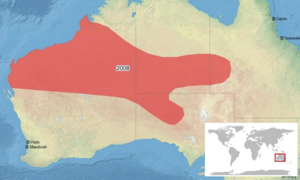Desert spadefoot toad facts for kids
Quick facts for kids Desert spadefoot toad |
|
|---|---|
| Conservation status | |
| Scientific classification | |
 |
The desert spadefoot toad (Notaden nichollsi) is a special type of frog found only in Australia. It belongs to a family of frogs called Limnodynastidae, also known as Australian ground frogs. This amazing toad lives in very dry places like deserts, grasslands, and marshy areas that sometimes dry up. To survive the hot Australian desert, it burrows deep underground and is mostly active at night.
Contents
Where Does This Toad Live?
The desert spadefoot toad lives in many parts of Australia. You can find it in the southern Kimberley and Pilbara regions of Western Australia. It also lives in the southern desert areas of the Northern Territory and reaches as far as Western Queensland.
This frog loves sandy places. It prefers deep sand because it helps hold water, which is super important in dry areas. For example, in the Gibson Desert in central Australia, these toads are often found in sand dunes.
What Kind of Frog Is It?
The desert spadefoot toad, Notaden nichollsi, was first described by a scientist named George Howard Parker in 1940. It's part of the Limnodynastidae family, which are often called Australian ground frogs. The group it belongs to, Notaden, was named by Albert Günther way back in 1873.
The Limnodynastidae family has many different kinds of frogs in Australia. They are good at living in various places, including on land, underground, and near water. The desert spadefoot toad is special because of how it lives in the dry desert.
How Does It Live and Behave?
One cool thing about male desert spadefoot toads is their call during breeding season. They make "oo-oo" sounds, a bit like a pigeon cooing. This call helps them find female toads and mark their space.
To survive the extreme heat and dryness, these toads are super adaptable. They can burrow deep under the soil. They also go into a special dormant state called aestivation when water is scarce. Aestivation is like hibernation, but for hot, dry times. It helps them save energy and water.
Unlike some other frogs, the desert spadefoot toad doesn't make a cocoon to protect itself during aestivation. Instead, it relies on the moisture in the soil around it. The amount of water in the soil helps the frog absorb water and stop its own body water from drying out through its skin. This way, they can manage their water levels well.
Burrowing also protects them from very hot temperatures and predators. These burrows are safe spots for them to hide, especially when it's super hot or dry. They also use these safe spots for breeding and for their tadpoles to grow.
Like other frogs, the desert spadefoot toad has a hormone called arginine vasotocin. This hormone helps them save water and stay hydrated.
After it rains, these toads come out from underground. This is when they look for food and find partners to breed with.
What Does It Eat?
Scientists have studied what the desert spadefoot toad eats. They found that toads near the Ethabuka Reserve, north of the Simpson Desert, eat only termites and ants. This makes sense because ants are common in the sand dunes and plains at night, which is when these toads are active.
How Does It Reproduce?
After heavy rainfall, the desert spadefoot toads breed in flooded areas. These areas often have sandy soil with clay-pans that fill with water. In these temporary pools, their tadpoles can grow very quickly, sometimes in just 30 days!
It's thought that male frogs float in the water and make their unique calls to attract females. Females might then lay up to 1000 eggs in jelly-like chains. However, scientists are still working to confirm all the details of this process.
The tadpoles of the desert spadefoot toad develop quite fast, changing into frogs in just over two weeks.
While we know they reproduce when conditions are good, there's still more to learn about how they breed. For example, we don't fully understand the tadpole stage of Notaden nichollsi because there isn't much information yet. More research is needed to learn all about their reproduction and how their young develop.
How Is It Protected?
The desert spadefoot toad is currently listed as a Least Concern species on the IUCN Red List of Threatened Species. This means it's not facing major threats right now that would put it in danger. But it's still important to keep an eye on their populations and where they live to make sure they stay safe in the long run.
The main way to protect the desert spadefoot toad is to save its special habitat. These frogs mostly live in sandy and clay soils in dry regions. They rely on their burrows for shelter and for raising their young. We need to protect and manage these habitats. This means stopping things like habitat loss, damage, and breaking up their homes caused by human activities like clearing land and building cities.



